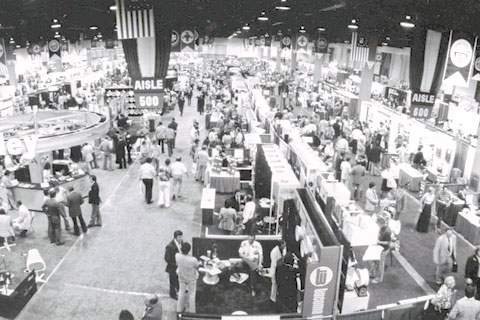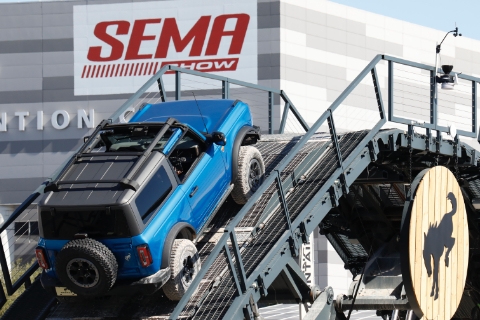SEMA News—June 2013
Q&A With Tim Martin
 SEMA News: Why are you running for the Chair-Elect position on the SEMA Board of Directors?
SEMA News: Why are you running for the Chair-Elect position on the SEMA Board of Directors?
Tim Martin: SEMA plays an important role in protecting and growing our industry and our lifestyle of vehicle customization, restoration and motorsports. These areas are threatened by change. We need our industry association to help grow our unique markets and help prevent the specialty aftermarket from being harmed by unnecessary government regulations. SEMA has the financial resources and critical mass to make a difference. As SEMA chairman, I will ensure that SEMA resources are used wisely to help expand awareness of our industry and lifestyle, protect the rights of consumers to modify and restore their vehicles, promote grassroots motorsports and help businesses succeed by providing useful research, educational programs, legislative advocacy, industry standards, marketing programs, networking and other business services needed by SEMA members. I will work to help SEMA improve the services it provides to manufacturers, distributors and independent businesses that sell and install vehicle modifications and other performance parts.
SN: For small businesses, the past five years have been focused on coping with the recession. Now that the economy is slowly beginning to improve, what do you think is the biggest challenge facing small businesses? What should the association be doing to help?
| Tim Martin We have an opportunity to grow the specialty-equipment market through positive media initiatives and favorable legislation that protects and promotes the rights of a consumer to personalize and customize their vehicles. SEMA can play a key role in growing positive awareness and media coverage of the aftermarket to foster industry growth. SEMA is uniquely positioned to address legislative challenges facing SEMA members. Regulations and laws designed around automotive replacement parts are not always friendly toward vehicle customization or performance products and accessories. Legislation has already outlawed many forms of modifications that were once common. Many forms of racing are threatened by regulation. Manufacturers and resellers cannot address this problem easily on their own. SEMA should foster industry collaboration and best practices through programs and services that evolve to the changing needs of the market and SEMA members. The SEMA Data Co-op is improving the flow of product information from manufacturers to distributors and resellers while reducing cost. The new SEMA Product Development Center will benefit SEMA members and expand awareness of the great products SEMA members sell. I am a vice president at K&N Engineering. I have worked in the SEMA marketplace for 15 years, and I have 25 years of experience in operations, engineering, information technology, marketing and management. I have extensive experience with aftermarket product data standards, technology standards, product testing and industry best practices. My education includes degrees in engineering and management. I have served on the SEMA Board of Directors, SEMA Data Co-op Board of Directors, SEMA Business Technology Committee (BTC) and several SEMA working groups. I have been a speaker at the Manufacturers’ Rep Council (MRC) annual meeting, Performance Warehouse Association (PWA) conference, the AAIA/SEMA Aftermarket eForum conference and the AAIA National Catalog Managers Association (NCMA) conference. I am passionate about racing and performance, but also about promoting the street-car customization lifestyle and ensuring that it remains a healthy segment of the aftermarket. I will work to encourage collaboration and expand programs addressing marketing, legislative issues, technology, industry best practices and member services to strengthen and grow the SEMA market. | |
TM: Small businesses will continue to be challenged by a variety of economic and regulatory pressures. Aftermarket small businesses must work to find new ways to provide valued products and services to consumers while abiding by local and federal regulations, including new requirements such as health insurance. SEMA has always connected manufacturers with the small businesses and people who sell premium automotive customization and racing products. SEMA should continue to look for ways to efficiently educate small business owners about new products, industry trends and better business practices that help them succeed. SEMA should also work to identify new challenges to small independent aftermarket businesses so that SEMA can create new programs and discounted services that address these needs to help businesses more effectively market and sell specialty products.
SN: Recruiting young people to work in the specialty-equipment industry continues to be an important initiative at SEMA. As chairman, what do you hope to accomplish on this issue beyond supporting SEMA’s existing programs?
TM: I chaired the SEMA Next Generation Task Force in 2013, and we identified several ways that SEMA can expand youth education, outreach and recruiting programs. Educational institutions are eager to partner with SEMA to create opportunities for their students. This includes high schools, vocational schools, colleges and post-graduate research institutions. Youth motorsports affiliations can also provide large populations of people interested in vehicle performance and customization. These provide a great opportunity for SEMA to expand awareness of the aftermarket and at the same time help member companies find talented people. I will work to ensure that SEMA improves programs and services that benefit industry professionals as well as people considering careers in the aftermarket.
SN: The SEMA Data Co-op is beginning to gain critical mass in terms of industry participation, with nearly 200 suppliers and 142 receivers participating. Yet there remains an opportunity to build further infrastructure to accommodate the needs of different segments as well as new tools to make the process easier. Where do you see the SEMA Data Co-op in five years, and what kind of priority would you assign to move the project closer to achieving its goal of opening sales to new customers?
TM: The SEMA Data Co-op provides a huge opportunity to address unique needs of various specialty product and service segments. We cannot rely on OEM and direct replacement parts approaches to ensure that unique specialty products and services are described properly and marketed effectively. Gaps in information create missed opportunities that reduce sales or result in dissatisfied customers.
The SEMA Data Co-op creates a foundation of tools to help create better information and provide data capabilities and unified distribution that help cost-effectively maintain synchronized data between manufacturers and sellers. From this foundation, SEMA will create integrated data products, selling tools and marketing programs that build awareness and create opportunities for a wide variety of SEMA members. SEMA can be much more active in the marketing of our industry to consumers. The SEMA Data Co-op will support effective marketing platforms that make it possible to expand consumer awareness about vehicle customization and provide mechanisms for manufacturers, distributors, retailers and installers to collaborate in that process. I would place a very high priority on this initiative and feel that technology changes and regulatory threats make this more important than ever.
SN: Designing parts that synchronize and complement the latest breakthroughs in automotive technology requires a substantial research-and-development investment. During your tenure as chairman, what advancements would you like to see in the benefits and services SEMA offers to member companies in the manufacturing sector to enable them to cope with changes now on the horizon?
TM: SEMA can help in various segments with research and product development support services. SEMA has placed additional emphasis on vehicle technology and research programs. The new SEMA product development center provides many opportunities for SEMA to help manufacturers with research and development, vehicle fitment, testing, other beneficial services and good advice. SEMA can help to obtain vehicle information, vehicle measurement data, interfaces and performance information.
SEMA can provide better aftermarket industry collaboration with vehicle manufacturers and expand Technology Transfer. SEMA can help vehicle manufacturers better appreciate aftermarket products and our industry. SEMA can provide performance and regulatory compliance test services, prototyping, fit testing, photography, media outreach, training and other services that help manufacturers get better products to market faster and cheaper.
SN: In both the Middle East and China, SEMA now hosts successful events designed to introduce our members to these markets with meetings between manufacturers and buyers, and more of these kinds of events are in the planning stages. How should we decide about which new markets to prioritize as SEMA-member companies increase their ability to sell globally?
TM: The SEMA trips to China and the Middle East have been effective ways for manufacturers to introduce products to new markets, and this tends to expand awareness and grows the market for everyone. SEMA should expand these programs significantly. The expansion can be based on regional vehicle populations or other data to indicate regional interest. There are automotive trade shows around the world, but many of these miss the SEMA focus on racing, performance, customization and restoration. Our ability to expand global awareness of these unique lifestyles is important in an era of expanding global regulation. SEMA global outreach programs expand our industry footprint and help members work together to address common challenges.








